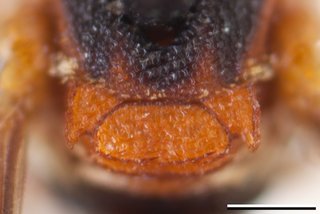
Thomas Onuferko · 9
Epeolus carolinus, Axillae mesoscutellum female |
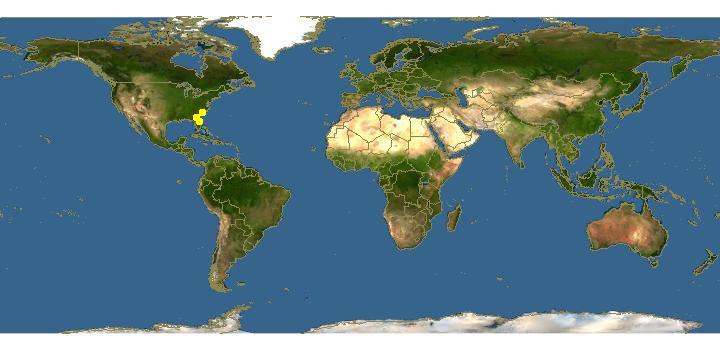
Click on map for details about points.
|
80x5 -
240x3 -
240x4 -
320x1 -
320x2 -
320x3 -
640x1 -
640x2
Set display option above.
Click on
images to enlarge. |
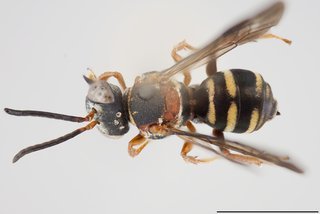
Thomas Onuferko · 9
Epeolus carolinus, Dorsal view female |
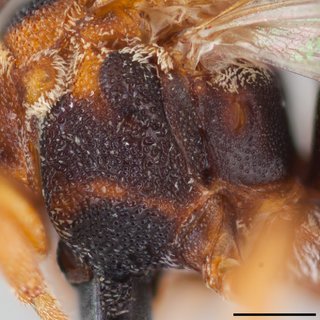
Thomas Onuferko · 9
Epeolus carolinus, female mesopleuron |
|
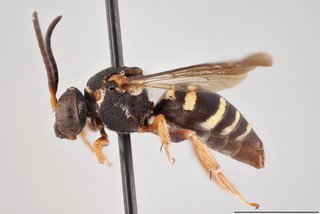
Thomas Onuferko · 9
Epeolus carolinus, Lateral view female |
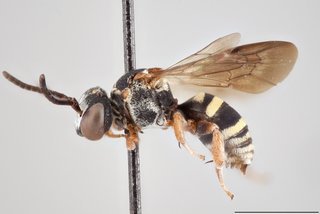
Thomas Onuferko · 9
Epeolus carolinus, Lateral view male |
|
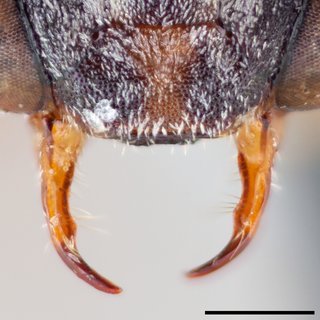
Thomas Onuferko · 9
Epeolus carolinus, Mandibles female |
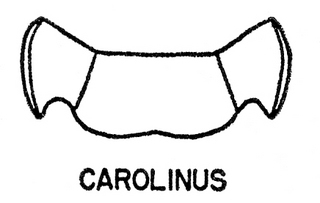
© Rebekah Andrus Nelson
· 1
Epeolus carolinus, both, top of thorax |
|
Overview |
Reprinted with permission from: Mitchell, T.B. 1962 Bees of the Eastern United States. North Carolina Agricultural Experiment Station Technical Bulletin No. 152.
FEMALE�Length 7-8 mm.; black, basal segments of antennae, mandibles,, and legs in large part, tubercles, tegulae and margin of pronotum, testaceous; mid and hind spurs more piceous; scutellum and axillae more ferruginous; lateral ocelli separated from margin of vertex by about their own diameter; segments of flagellum quite elongate, breadth of median segments only slightly more than half the length, brownish-piceous; cheeks about half width of eyes, somewhat narrower below, hind margin subcarinate; median length of labrum somewhat more than half the breadth, with a pair of low but distinct, subapical denticles; mandibles very slender, with a barely perceptible,. submedian angle on inner margin; posterior margin of scutellurn nearly straight, not noticeably impressed (fig. 110); axillae strongly divergent from lateral margins of scutellurn, acute apically, strongly carinate laterally, resulting in
distinct lateral surface that is more or less compressed; wings with the usual three submarginal cells, rather deeply infuscated, veins brownish-piceous; face around antennae rather densely silvery tornentose, and venter of thorax with considerable silvery tomentum, this fading out on lateral surfaces of pleura; margin of pronotum quite densely yellow tomentose, and tubercles fringed with short yellow tomentum; metanotum yellow tomentose beneath the rather strongly over-hanging scutellurn; abdominal terga 1-4 with transverse, dense, yellow tornentose fasciae, these more or less interrupted medially, quite broad on tergum 1, becoming successively narrower on 2, 3 and 4, tergum 5 with an area on each side of thin whitish and rather obscure tomenturn; vertex, cheeks and upper part of face quite closely and rather coarsely rugoso-punctate, becoming very densely and minutely punctate below; pleura rather coarsely rugosopunctate below, with some irregular, narrow, shining spaces evident, becoming densely rugose above; scutum rather coarsely and densely rugose, scutellurn more coarsely rugosopunctate, with no intervening spaces evident; tegulae very finely and closely but quite distinctly punctate throughout; abdominal terga with very fine and close, uniformly distributed punctures, these becoming slightly more minute and crowded on the more apical terga; pseudopygidium very short and obscure, median length but a fraction of the apical width.
MALE�Answers to description of female in general, but segments of antennal flagellum scarcely longer than broad, venter of thorax more densely silvery tomentose, and pleura with a thin covering of whitish, plumose hairs; scutellum and axillae often black; pygidial plate rather narrow, narrowly rounded apically, median length somewhat greater than basal width, margin carinate, surface very shallowly and obscurely punctate.
TYPES � Holotype: Male, Kill Devil Hills, Dare Co., N. C., Sept. 12, 1956 (Mitchell, on Eupatorium) [author�s coll.].
Allotype: New River, N. C., Sept. 20-30, 1944 (G. E. Bohart). Paratypes: 3 ♂♂, 3 ♀♀, New River, N. C., Sept. 20-30, 1944 (Bohart) ; 13 ♂♂, Kill Devil Hills, N. C., Sept. 12 & 13, 1956 (Mitchell, on Eupatorium); 5 ♂♂, Kill Devil Hills, N. C., Sept. 8-14, 1956 (Krombein); 1 ♀, Gainesville, Fla., 11-6-46 (H. V. Weems, Jr.).
Paratypes are in collections of the U. S. National Museum, G. E. Bohart, the State Plant Board of Florida and the author.
|
|
|
Identification | |
Extracted from: Onuferko TM (2018). A revision of the cleptoparasitic bee genus Epeolus Latreille for Nearctic species, north of Mexico (Hymenoptera, Apidae). ZooKeys 755: 1–185. https://doi.org/10.3897/zookeys.755.23939
Diagnosis. The following morphological features in combination can be used to tell E.
carolinus apart from all other North American Epeolus: the mandible has a blunt, obtuse preapical tooth; the axilla is elongate, extending well beyond the midlength of the
mesoscutellum but not beyond its posterior margin, and the free portion is distinctly
hooked; the mesopleuron is closely (most i<1d) and evenly punctate; and the metasomal fasciae are yellow to orange and interrupted medially. Epeolus carolinus resembles
E. deyrupi in general appearance, but in E. deyrupi the axilla is larger, extending as far
back as or beyond the posterior margin of the mesoscutellum, and dilated laterally
but relatively straight along the medial margin, and the mesopleuron commonly has
sparser punctures ventrolaterally (i≤2d) than that of E. carolinus, with the interspaces
shining or somewhat dull due to tessellate surface microsculpture.
Redescription. MALE: Length 6.5 mm; head length 1.8 mm; head width 2.4
mm; fore wing length 5.7 mm.
Integument coloration. Mostly black; notable exceptions as follows: partially to entirely ferruginous on mandible, antenna, pronotal lobe, tegula, axilla, mesoscutum,
mesoscutellum, legs, and pygidial plate. Mandible with apex darker than rest of mandible; preapical tooth slightly lighter than mandibular apex (difficult to see in holotype;
described from paratype). Antenna brown except scape, pedicel, and F1 extensively
orange. Pronotal lobe and tegula pale ferruginous to amber. Mesoscutum with orange
spot anterolaterally between pronotal lobe and tegula. Wing membrane subhyaline,
apically dusky. Legs more extensively reddish orange than brown or black.
Pubescence. Face with tomentum densest around antennal socket. Tomentum
slightly sparser on clypeus; upper paraocular and frontal areas, and vertexal area mostly
exposed. Dorsum of mesosoma and metasoma with bands of off-white and yellow
short appressed setae. Mesoscutum with paramedian band. Mesopleuron densely hairy,
except for two sparsely hairy circular patches (one behind pronotal lobe, a larger one occupying much of ventrolateral half of mesopleuron). Metanotum with tomentum
sparser medially, uniformly off white. T1 with discal patch quadrangular and very
wide, the basal and apical fasciae only narrowly joined laterally by few sparsely scattered pale hairs (not joined in paratype and multiple non-type specimens). T1–T5
with apical fasciae interrupted medially, those of T2–T4 somewhat broader laterally,
T2 with fascia without anterolateral extensions of tomentum. T6 with fascia complete.
S4 and S5 with long coppery to silvery subapical hairs.
Surface sculpture. Punctures dense. Labrum with larger punctures than clypeus,
but punctures of both equally dense (i<1d). Impunctate spot lateral to lateral ocellus
absent. Mesoscutum, mesoscutellum, and axilla coarsely and densely rugose-punctate.
Tegula very densely punctate mesally (i<1d), much less so laterally (i>2d). Mesopleuron with ventrolateral half densely punctate (i<1d) to rugose; mesopleuron with punctures more or less equally dense throughout. Metasomal terga with punctures very fine,
dense (i≈1d), evenly distributed on disc.
Structure. Preapical tooth inconspicuous, blunt and obtuse. Labrum with pair of
small subapical denticles not preceded by carinae. Frontal keel not strongly raised. Scape
with greatest length 1.8 × greatest width. F2 noticeably longer than wide (L/W ratio
= 1.4). Preoccipital ridge not joining hypostomal carina, from which it is separated by
less than 1 MOD at its terminal (difficult to see in holotype; described from non-type
specimens). Mesoscutellum weakly bigibbous. Axilla large, its lateral margin (L) more
than half as long as mesoscutellar width (W) (L/W ratio = 0.6) and tip extending well
beyond midlength of mesoscutellum but not as far back as its posterior margin; axilla
with tip conspicuously diverging from side of mesoscutellum, distinctly hooked, and
axilla with free portion 2/5 its medial length; axilla with lateral margin arcuate and carinate. Fore wing with three submarginal cells. Pygidial plate apically rounded, with large
deep punctures more or less evenly spaced throughout, with the interspaces shining.
FEMALE: Description as for male except for usual secondary sexual characters and
as follows: F2 even longer than wide (L/W ratio = 1.7); T5 with pseudopygidial area
lunate, its apex more than twice as wide as medial length, indicated by silvery setae
on flat disc of apicomedial region elevated from rest of tergum; S4 and S5 with much
shorter hairs (S5 with apical fimbria of coppery to silvery hairs not extending beyond
apex of sternum by more than 1/4 MOD); pygidial plate apically truncate, with small,
denser punctures.
|
|
|
Names | |
|
|
| Supported by | |
Updated: 2024-04-27 03:12:13 gmt
|